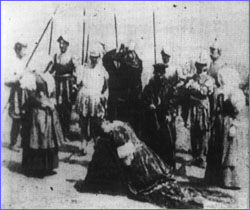
|
 |
 |
Motion pictures are invented, and filmmakers find magic in the movies. 1895 The Lumière Brothers debut the cinématographe, showing the first projected moving pictures to an audience in Paris. The Lumières thrill early audiences with documentary fare like "Feeding the Baby." Reportedly, patrons at a screening of "The Arrival of a Train" flee the theater in terror, fearing that the locomotive would burst through the screen. 1895 Alfred Clark of the Edison Kinetoscope Company figures out how an actress can be decapitated—without losing her head—for "The Execution of Mary Queen of Scots," reputed to be the first special effect. The substitution shot becomes an effects standard. 1898 French magician George Méliès begins making films for his magic act, using camera tricks like multiple exposure, miniatures and stop-motion animation, earning him the title of "grandfather of special effects." He produces more than 500 films, including "A Trip to the Moon" (1902). Continue: 1900s Reel Timeline | 50-Foot Chicken | Wizards of Ahs | Be in Pixels Titanic: What's Real | Virtual Humans | Resources | Teacher's Guide Transcript | Site Map | Special Effects Home Editor's Picks | Previous Sites | Join Us/E-mail | TV/Web Schedule About NOVA | Teachers | Site Map | Shop | Jobs | Search | To print PBS Online | NOVA Online | WGBH © | Updated November 2000 |
 1895 - The execution of Mary Queen of Scots
1895 - The execution of Mary Queen of Scots